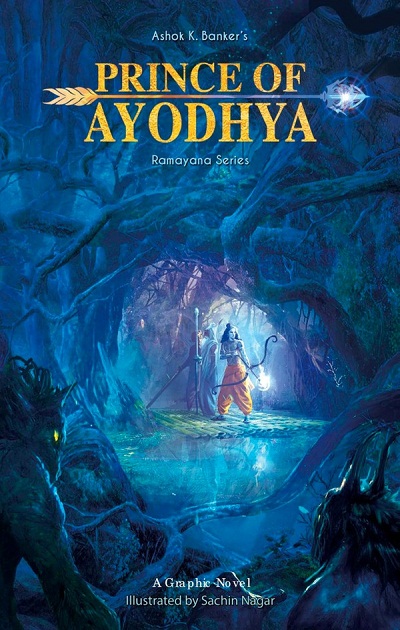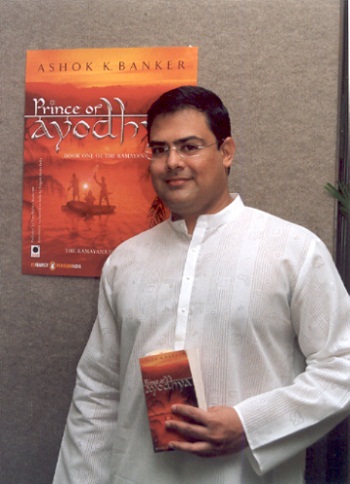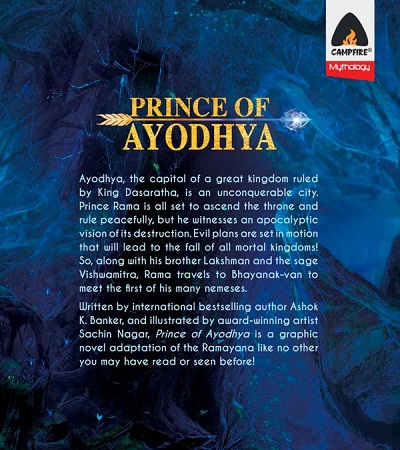 I clearly remember the time when as a child I used to listen to my grandad recite the epics – The Mahabharata and The Ramayana as enthralling stories. The magnanimity, grandeur and larger-than-life characters have always thrilled me. Over the years, I came to realise something that my teacher said when I was in fifth standard- “Whatever isn’t present in these epics aren’t there in this country”. These epics are still relevant and modern these epics are that we discover something new everytime we read them.
I clearly remember the time when as a child I used to listen to my grandad recite the epics – The Mahabharata and The Ramayana as enthralling stories. The magnanimity, grandeur and larger-than-life characters have always thrilled me. Over the years, I came to realise something that my teacher said when I was in fifth standard- “Whatever isn’t present in these epics aren’t there in this country”. These epics are still relevant and modern these epics are that we discover something new everytime we read them.
There have been countless adaptations and retellings of the epics – be it in films or series or graphic novels, the trend isn’t stopping anytime soon. Recently, author and screenwriter, Ashok K Banker launched the first book of his eight part adaptation of the epic The Ramayana. Titled Prince of Ayodhya, the book launched in December 2019 in India and will be coming in trade paperback in July 2020 from Penguin Random House USA and Campfire.
Banker’s areas of expertise include – mythology, crime thrillers, essays, literary criticism and fiction. He was also writing for DC Comics on graphic novels and has now returned to India for his mythological adaptation. Back in 2010, DC Comics purchased an original graphic novel script of his Becoming Kali and the film rights were purchased for development by Warner Bros the year afterwards. But, unfortunately both the projects were shelved and he went on to write different projects. His credits include over 70 books that have sold over three million copies in 22 languages and 62 countries worldwide.
AnimationXpress was lucky enough to have an interview that turned out in insightful conversation. Excerpts from the conversation :
1. Why did you decide to adapt The Ramayana in an eight part series, given there have been adaptations before?
Back in the late 1990s when I began working on my retellings of Indian mythology, there were no English-language retellings of the myths and epics, apart from academic translations and old versions for children (Rajgopalachari, Munshi, and so on). In the West, they retell their ancient myths and legends constantly in new and creative ways. There are literally tens of thousands of different variations on the same classic stories. I felt there was surely room in India or at least one sincere retelling of our great stories for a contemporary readership.
I began my Ramayana without knowing how long or how many books it would take. It ended up being eight books written over almost a decade. Each book was 500 to 700 pages long. It was only natural that each book should be adapted to a full-length graphic novel. Even then, I had to condense the story considerably and eliminate several supporting characters and subplots. In the end, I’m very satisfied with the result!

2. How are you dividing the epic in eight parts given it’s so vast? Tell us about the first book – Prince of Ayodhya?
My Ramayana Series is one epic story split into eight parts. The first book Prince of Ayodhya tells the story of Rama and his family in Ayodhya when he was 15 years old. We see his innocent youthful days and his relationship with his brothers, his mother, the other Queens, his father, other characters, and the gradual rise of the threat of Ravana, whose plans to invade the mortal realm are gathering momentum.
There are forces within Ayodhya that work secretly for Ravana, trying to breed rebellion within the kingdom, and sabotage the royal family through internal conflict. The main plot concerns the arrival of the 246-year old brahmarishi Vishwamitra who seeks to take young prince Rama to the dreaded Bhayanak-van to end the menace of the yaksi Taraka, who is Ravana’s emissary. The book ends with an epic battle in the haunted forest where Rama and Lakshman and Vishwamitra face the monstrous children of the giantess and finally, in a climactic showdown, Tataka herself. This is the plot of the graphic novel. The prose novel has much more detail and subplots of course but Sachin Nagar’s powerful art portrays the key events, characters and battle action brilliantly.
3. Please throw some light on the rest of the books with little brief if possible?
The rest of the Ramayana Series continues the adventures of Rama, Lakshman, and later, Sita, Hanuman and other protagonists as well, all the way until the Luv Kush story and the final samadhi of Rama and Lakshman at the end of their lives.
4. There are several translations of the epic, from where are you drawing inspiration and information?
Having written several thousand pages of my Ramayana Series, that’s inspiration enough! Writing the series was a labour of love that took decades of research and study of the Ramayana, but in the end, everything you read in the novels, or see in the graphic novels is my imaginative (and often fantastical) interpretation of this classic story. As of now, my Ramayana series has sold well over a million copies worldwide in 17 languages and 26 countries. It’s considered the most widely known read and loved, Ramayana of all time. I’m thrilled to have the opportunity to retell my very unique take on this timeless tale once again through the wonderful cinematic medium of graphic novels starting with Prince of Ayodhya.
 5. Why do you think it’s still relevant in today’s time?
5. Why do you think it’s still relevant in today’s time?
More people are reading books today than ever before in the history of the world. The sheer volume, sales and reach of books across the world, especially in the West, is growing even today at amazing rates. Young people in particular are reading books – the Forbes annual list of top earners includes several children’s book authors who earn tens of millions in royalties each year and sell tens of millions of copies of their books. Each generation wants to hear the stories of their culture retold in a way that appeals to their sensibility. The greatest stories will always be retold, time and time again, and will always find an audience – only the style of retelling will change in each era.
I think my Ramayana series struck a chord in tens of lakhs of Indian and international readers who saw the timeless appeal of this great story and these legendary characters. It’s an inspiring tale of one man, one family’s struggles to remain good and do good in the face of impossible odds, while battling evil. They don’t always succeed, and many people now speak of Rama’s glaring errors of judgement and action, but those very errors make his achievements all the greater. He may have been ‘Maryada Purshottam’ to many, but he was at the core, intensely, unavoidably, human. This is a great story of human struggle and endurance and it will live forever. Even today, almost twenty years after its first publication and almost three decades since I began writing it, I constantly receive fan mail from young, teenage readers who have discovered the books for the first time and fall in love with them.
6. Tell us about your journey till date as a graphic novel writer?
I fell in love with comics at a very young age, before the age of 10. I was already a precocious reader of books by that time, and read voraciously. Comics were a whole different way of storytelling. In my teens, I even registered three comic book imprints with the Mumbai registrar of periodicals and sought funding to start my own comic book publishing company. I came close to starting up but at the last minute, the funding fell through. I never stopped trying and over time, I wrote comics and graphic novels for several publications, often using pseudonyms as they were work-for-hire assignments. My goal was always to write original graphic novels that were my own creation. I have yet to achieve all my goals as a graphic novelist but I will never stop trying!
 Even now, I’m working with several brilliant artists on a number of original projects. As is my policy, I’d prefer to talk about them only once they’re published. Several years ago, the head of Vertigo Comics (a part of the DC group) contacted me to ask if I would like to write a graphic novel for them. I happily agreed. Vertigo is a great imprint with some phenomenal titles. I developed and created an original graphic novel titled Becoming Kali. It was a wonderful experience and so interactive at every stage. There was daily communication between all of us, and every single line, breakdown, panel and art was discussed and perfected. There is a reason why American comics publishers produce such a high level of quality: they take the medium very seriously and work to perfection. There is no compromise at every stage. And you get paid very well indeed!
Even now, I’m working with several brilliant artists on a number of original projects. As is my policy, I’d prefer to talk about them only once they’re published. Several years ago, the head of Vertigo Comics (a part of the DC group) contacted me to ask if I would like to write a graphic novel for them. I happily agreed. Vertigo is a great imprint with some phenomenal titles. I developed and created an original graphic novel titled Becoming Kali. It was a wonderful experience and so interactive at every stage. There was daily communication between all of us, and every single line, breakdown, panel and art was discussed and perfected. There is a reason why American comics publishers produce such a high level of quality: they take the medium very seriously and work to perfection. There is no compromise at every stage. And you get paid very well indeed!
7. Adapting an epic into a graphic novel is a strenuous job. What kind of challenges have you faced?
Writing and creating a graphic novel is a wonderful, enjoyable experience. There is no other reason to be a creator unless you love it! For my part, since I was adapting my own novel, and was very familiar with the grammar and medium of graphic novels, it was quite simple and great fun. There were challenges on the editorial and publishing front, due to the extreme differences between the contemporary professional style of working followed in international comic publishing companies and the relatively conservative mindset of the Indian publishing company. The main difference is in workflow: the international publishers regard a graphic novel as an equal collaboration between artist and writer and they are the ones who engage directly with each other and maintain a strong, constant interaction, resulting in a powerful collaborative creation.
It’s quite different in India. I hope things will change and India will come into the 21st century in this respect as well! Still, thanks to a strong script and a very talented and determined artist, Sachin Nagar has managed to do a great job against the odds. His art is a shining example of Indian talent that deserves its place on the world graphic novel scene. He is a brilliant artist equal to any of those working for DC or Marvel. He should be in charge of his own imprint!
